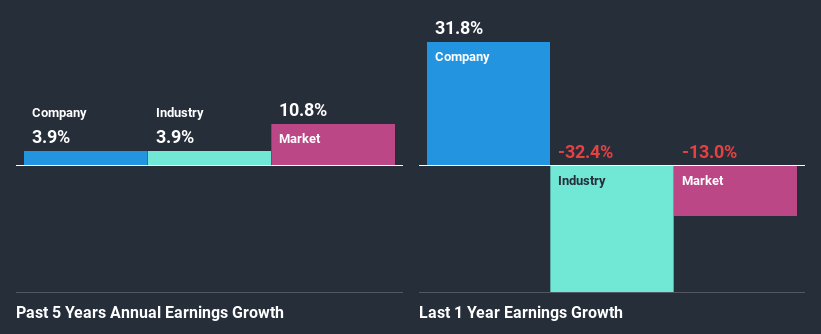Bloomsbury Publishing plc (LON:BMY) Stock Is Going Strong But Fundamentals Look Uncertain: What Lies Ahead ?
Bloomsbury Publishing's (LON:BMY) stock is up by a considerable 27% over the past three months. However, we decided to pay attention to the company's fundamentals which don't appear to give a clear sign about the company's financial health. Particularly, we will be paying attention to Bloomsbury Publishing's ROE today.
Return on equity or ROE is an important factor to be considered by a shareholder because it tells them how effectively their capital is being reinvested. Simply put, it is used to assess the profitability of a company in relation to its equity capital.
See our latest analysis for Bloomsbury Publishing
How To Calculate Return On Equity?
The formula for return on equity is:
Return on Equity = Net Profit (from continuing operations) ÷ Shareholders' Equity
So, based on the above formula, the ROE for Bloomsbury Publishing is:
7.5% = UK£12m ÷ UK£159m (Based on the trailing twelve months to August 2020).
The 'return' is the amount earned after tax over the last twelve months. So, this means that for every £1 of its shareholder's investments, the company generates a profit of £0.07.
What Is The Relationship Between ROE And Earnings Growth?
We have already established that ROE serves as an efficient profit-generating gauge for a company's future earnings. We now need to evaluate how much profit the company reinvests or "retains" for future growth which then gives us an idea about the growth potential of the company. Assuming all else is equal, companies that have both a higher return on equity and higher profit retention are usually the ones that have a higher growth rate when compared to companies that don't have the same features.
A Side By Side comparison of Bloomsbury Publishing's Earnings Growth And 7.5% ROE
At first glance, Bloomsbury Publishing's ROE doesn't look very promising. Yet, a closer study shows that the company's ROE is similar to the industry average of 6.9%. On the other hand, Bloomsbury Publishing reported a fairly low 3.9% net income growth over the past five years. Bear in mind, the company's ROE is not very high . So this could also be one of the reasons behind the company's low growth in earnings.
Next, on comparing Bloomsbury Publishing's net income growth with the industry, we found that the company's reported growth is similar to the industry average growth rate of 3.9% in the same period.
Earnings growth is an important metric to consider when valuing a stock. It’s important for an investor to know whether the market has priced in the company's expected earnings growth (or decline). Doing so will help them establish if the stock's future looks promising or ominous. If you're wondering about Bloomsbury Publishing's's valuation, check out this gauge of its price-to-earnings ratio, as compared to its industry.
Is Bloomsbury Publishing Using Its Retained Earnings Effectively?
Bloomsbury Publishing has a three-year median payout ratio of 62% (implying that it keeps only 38% of its profits), meaning that it pays out most of its profits to shareholders as dividends, and as a result, the company has seen low earnings growth.
In addition, Bloomsbury Publishing has been paying dividends over a period of at least ten years suggesting that keeping up dividend payments is way more important to the management even if it comes at the cost of business growth. Based on the latest analysts' estimates, we found that the company's future payout ratio over the next three years is expected to hold steady at 50%.
Summary
Overall, we have mixed feelings about Bloomsbury Publishing. While no doubt its earnings growth is pretty respectable, the low profit retention could mean that the company's earnings growth could have been higher, had it been paying reinvesting a higher portion of its profits. An improvement in its ROE could also help future earnings growth. With that said, the latest industry analyst forecasts reveal that the company's earnings are expected to accelerate. Are these analysts expectations based on the broad expectations for the industry, or on the company's fundamentals? Click here to be taken to our analyst's forecasts page for the company.
This article by Simply Wall St is general in nature. It does not constitute a recommendation to buy or sell any stock, and does not take account of your objectives, or your financial situation. We aim to bring you long-term focused analysis driven by fundamental data. Note that our analysis may not factor in the latest price-sensitive company announcements or qualitative material. Simply Wall St has no position in any stocks mentioned.
Have feedback on this article? Concerned about the content? Get in touch with us directly. Alternatively, email editorial-team@simplywallst.com.

 Yahoo Finance
Yahoo Finance 
